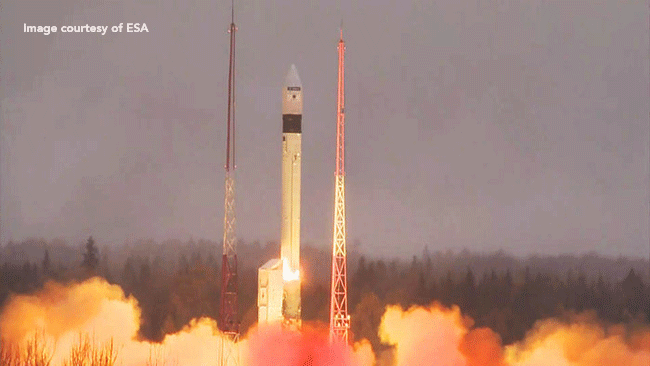Successful launch of Sentinel-5P

Right on time, at 9.27 hours GMT (11.27 hours CEST) on 13 October, Sentinel-5P was successfully blasted into space atop a Rockot launcher from Plesetsk Cosmodrome in northern Russia.
The Sentinel program, which forms part of the Global Monitoring for Environment and Security program called Copernicus, comprises five satellite families: Sentinel-1, designed to ensure the continuity of ERS and Envisat radar data, Sentinel-2 and -3, dedicated to Earth and ocean monitoring; and Sentinel-4 and -5, dedicated to meteorology and climatology missions, based on a study of the composition of the Earth’s atmosphere.
GMV is playing a key role in the Copernicus program, participating actively in various projects for both the ground and space segment. During launches it also provides support services for the mission planning and control systems.
For Sentinel-5P in particular GMV has set up the satellite control center as part of a wider-ranging project for the European Space Agency (ESA) and its European Space Operations Centre (ESOC).
GMV has also been responsible for development of the satellite’s operational simulator used actively to vet the mission’s flight-control procedures and for pre-launch training of spacecraft operators. As part of the abovementioned duties GMV’s development team gave ESOC in-situ support during the pre-launch months; this support will run up to the end of the Launch and Early Orbit Phase (LEOP).
At the same time GMV’s permanent ESOC team is contributing actively to development of the Flight Dynamics System (FDS) and operational support of the FDS.
Lastly, 2 GMV engineers have joined the Flight Control Team (FCT) of the satellite’s overall operations team.
With this launch Sentinel-5P is continuing along the path already marked out by the other five Sentinel satellites now in orbit, offering a vast amount of information on our planet and a series of key services for a varied range of applications.
Sentinel-5P is Copernicus’s first Earth-atmosphere monitoring mission; once fully operative it will map the planet’s atmosphere daily with a resolution of up to 7 × 3.5 km. At this level of detail it will be possible to pinpoint cities’ air pollution.
The satellite carries advanced instrumentation capable of detecting numerous trace gases such as nitrogen dioxide, ozone, formaldehyde, sulphur dioxide, methane, carbon monoxide and aerosols, all of which affect the air we breathe and hence our health and the climate as a whole. With a swathe width of 2600 km it will map the entire planet every day. Among other services the mission will contribute to the monitoring of volcanic ash for aviation safety purposes and the triggering of high UV radiation alerts to warn of the danger of skin damage. Its readings will also enhance our knowledge of important processes in the atmosphere related to the climate and to the formation of holes in the ozone layer.